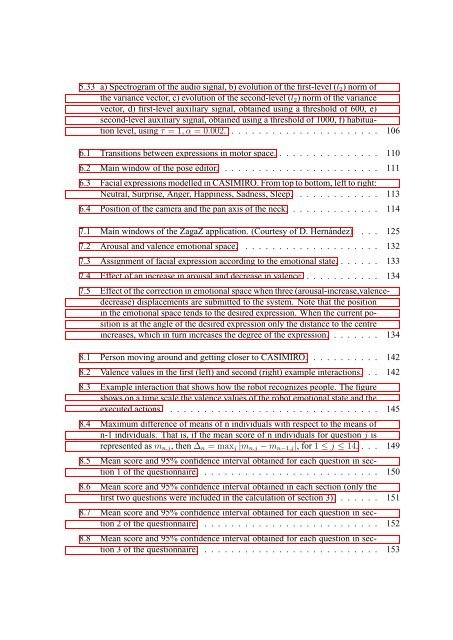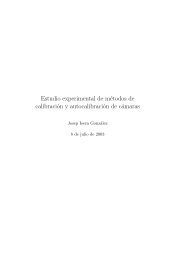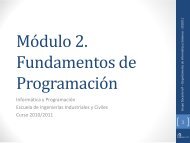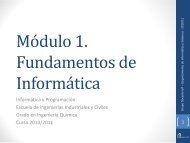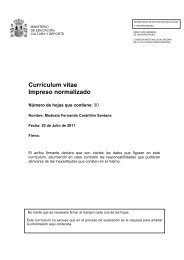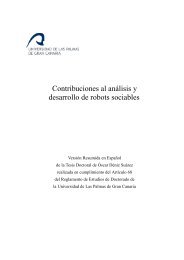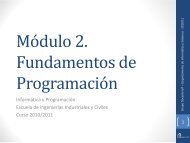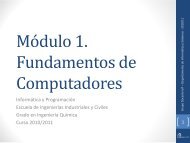PhD Document - Universidad de Las Palmas de Gran Canaria
PhD Document - Universidad de Las Palmas de Gran Canaria
PhD Document - Universidad de Las Palmas de Gran Canaria
You also want an ePaper? Increase the reach of your titles
YUMPU automatically turns print PDFs into web optimized ePapers that Google loves.
5.33 a) Spectrogram of the audio signal, b) evolution of the first-level (l2) norm of<br />
the variance vector, c) evolution of the second-level (l2) norm of the variance<br />
vector, d) first-level auxiliary signal, obtained using a threshold of 600, e)<br />
second-level auxiliary signal, obtained using a threshold of 1000, f) habituation<br />
level, using τ = 1, α = 0.002. . . . . . . . . . . . . . . . . . . . . . . 106<br />
6.1 Transitions between expressions in motor space. . . . . . . . . . . . . . . . 110<br />
6.2 Main window of the pose editor. . . . . . . . . . . . . . . . . . . . . . . . 111<br />
6.3 Facial expressions mo<strong>de</strong>lled in CASIMIRO. From top to bottom, left to right:<br />
Neutral, Surprise, Anger, Happiness, Sadness, Sleep. . . . . . . . . . . . . 113<br />
6.4 Position of the camera and the pan axis of the neck. . . . . . . . . . . . . . 114<br />
7.1 Main windows of the ZagaZ application. (Courtesy of D. Hernán<strong>de</strong>z) . . . 125<br />
7.2 Arousal and valence emotional space. . . . . . . . . . . . . . . . . . . . . 132<br />
7.3 Assignment of facial expression according to the emotional state. . . . . . . 133<br />
7.4 Effect of an increase in arousal and <strong>de</strong>crease in valence. . . . . . . . . . . . 134<br />
7.5 Effect of the correction in emotional space when three (arousal-increase,valence<strong>de</strong>crease)<br />
displacements are submitted to the system. Note that the position<br />
in the emotional space tends to the <strong>de</strong>sired expression. When the current position<br />
is at the angle of the <strong>de</strong>sired expression only the distance to the centre<br />
increases, which in turn increases the <strong>de</strong>gree of the expression. . . . . . . . 134<br />
8.1 Person moving around and getting closer to CASIMIRO. . . . . . . . . . . 142<br />
8.2 Valence values in the first (left) and second (right) example interactions. . . 142<br />
8.3 Example interaction that shows how the robot recognizes people. The figure<br />
shows on a time scale the valence values of the robot emotional state and the<br />
executed actions. . . . . . . . . . . . . . . . . . . . . . . . . . . . . . . . 145<br />
8.4 Maximum difference of means of n individuals with respect to the means of<br />
n-1 individuals. That is, if the mean score of n individuals for question j is<br />
represented as mn,j, then ∆n = maxj |mn,j − mn−1,j|, for 1 ≤ j ≤ 14. . . . 149<br />
8.5 Mean score and 95% confi<strong>de</strong>nce interval obtained for each question in section<br />
1 of the questionnaire. . . . . . . . . . . . . . . . . . . . . . . . . . . 150<br />
8.6 Mean score and 95% confi<strong>de</strong>nce interval obtained in each section (only the<br />
first two questions were inclu<strong>de</strong>d in the calculation of section 3). . . . . . . 151<br />
8.7 Mean score and 95% confi<strong>de</strong>nce interval obtained for each question in section<br />
2 of the questionnaire. . . . . . . . . . . . . . . . . . . . . . . . . . . 152<br />
8.8 Mean score and 95% confi<strong>de</strong>nce interval obtained for each question in section<br />
3 of the questionnaire. . . . . . . . . . . . . . . . . . . . . . . . . . . 153


